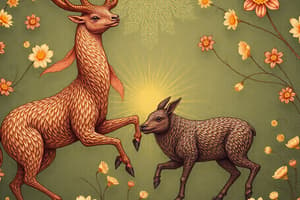Podcast
Questions and Answers
Which of the following scenarios BEST illustrates ovoviviparous reproduction?
Which of the following scenarios BEST illustrates ovoviviparous reproduction?
- A fish releases eggs and sperm into the water for fertilization.
- A mammal nourishes its developing offspring through a placenta.
- A bird lays an egg, which hatches outside the mother's body.
- A snake gives birth to live young that developed in eggs inside the mother. (correct)
A scientist observes a species of insect where females produce offspring without fertilization. This form of reproduction is BEST described as:
A scientist observes a species of insect where females produce offspring without fertilization. This form of reproduction is BEST described as:
- Parthenogenesis (correct)
- Regeneration
- Budding
- Binary fission
Which of the following characteristics is LEAST likely to be observed in offspring resulting from asexual reproduction?
Which of the following characteristics is LEAST likely to be observed in offspring resulting from asexual reproduction?
- Identical DNA sequences to the parent
- High degree of genetic variation (correct)
- Adaptation to a highly specific niche
- Rapid population growth in stable environments
A farmer notices that his legume crop is thriving even in nitrogen-poor soil. This is MOST likely due to the presence of:
A farmer notices that his legume crop is thriving even in nitrogen-poor soil. This is MOST likely due to the presence of:
In a forest ecosystem, a disease wipes out a significant portion of the photosynthetic plants. Which of the following consequences is MOST likely to occur?
In a forest ecosystem, a disease wipes out a significant portion of the photosynthetic plants. Which of the following consequences is MOST likely to occur?
Which of the following evolutionary advantages is MOST closely associated with sexual reproduction compared to asexual reproduction?
Which of the following evolutionary advantages is MOST closely associated with sexual reproduction compared to asexual reproduction?
A marine biologist is studying a species of starfish. She observes that a starfish that was cut into several pieces is now regenerating into multiple new individuals. This type of reproduction is an example of:
A marine biologist is studying a species of starfish. She observes that a starfish that was cut into several pieces is now regenerating into multiple new individuals. This type of reproduction is an example of:
Which of the following plant nutrient deficiencies would MOST directly impact the plant's ability to perform photosynthesis?
Which of the following plant nutrient deficiencies would MOST directly impact the plant's ability to perform photosynthesis?
Flashcards
Regeneration
Regeneration
Regrowing lost body parts; starfish can do this!
Fertilization
Fertilization
Sperm + egg = new organism.
External Fertilization
External Fertilization
Fertilization happens outside the female.
Ovoviviparous Reproduction
Ovoviviparous Reproduction
Signup and view all the flashcards
Asexual Reproduction
Asexual Reproduction
Signup and view all the flashcards
Viviparous Animals
Viviparous Animals
Signup and view all the flashcards
Oviparous Animals
Oviparous Animals
Signup and view all the flashcards
Parthenogenesis
Parthenogenesis
Signup and view all the flashcards
Study Notes
- Regeneration occurs when some animals, such as starfish, regrow lost body parts or form new individuals from body fragments.
- Fertilization is the union of a sperm and an egg to form a zygote, which develops into a new organism.
- External fertilization happens outside the female's body, often in water, common in amphibians and fish.
- Rhizobium bacteria is a type of symbiotic bacteria found in legumes, and helps fix nitrogen in the soil, contributing to both animal digestion and reproduction.
- Ovoviviparous reproduction is a reproductive method where offspring develop inside eggs that remain inside the mother’s body until they hatch, seen in some sharks and snakes.
- Asexual reproduction occurs when an organism produces offspring without fertilization, resulting in genetically identical individuals.
- Viviparous animals give birth to live young instead of laying eggs, examples are humans, dogs, and cats.
- Sperm is the male reproductive cell responsible for fertilization.
- Oviparous animals lay eggs for reproduction, such as birds, reptiles, and most fish.
- Parthenogenesis occurs when an egg develops into an individual without fertilization and is seen in certain reptiles, insects, and fish.
- Binary fission is a form of asexual reproduction where an organism splits into two identical individuals; this is commonly seen in bacteria and protists.
- Internal fertilization occurs inside the female's body, common in mammals, birds, and reptiles.
- Egg (Ovum) is the female reproductive cell that combines with the sperm during fertilization to form a new organism.
- Sexual reproduction requires two parents and results in genetic variation in offspring.
- Budding occurs when a new organism grows out of the body of the parent, as seen in hydra and yeast.
- Sunlight is the main source of energy for plants and is used in photosynthesis.
- Chlorophyll is a green pigment that captures light energy during photosynthesis.
- Plants take in carbon dioxide from the atmosphere for photosynthesis.
- Glucose is the primary product of photosynthesis and provides energy for the plant.
- Magnesium is essential for chlorophyll production.
- Plants obtain nitrogen primarily from the soil in the form of nitrates and ammonium.
- Autotrophic nutrition describes green plants that make their own food through photosynthesis.
- Transpiration is when plants release excess water in the form of vapor.
- Nitrogen is a macronutrient required in large amounts for plant growth.
- Phosphorus is essential for strong root systems and flower formation.
- Roots absorb most of the water and minerals needed by the plant.
- Potassium helps regulate water balance and enzyme functions in plants.
- Phosphorus is a macronutrient, not a micronutrient.
- Plant roots absorb water mainly through passive absorption by osmosis.
- Legumes have Rhizobium bacteria in their root nodules, which helps fix nitrogen from the air into the soil.
Studying That Suits You
Use AI to generate personalized quizzes and flashcards to suit your learning preferences.





